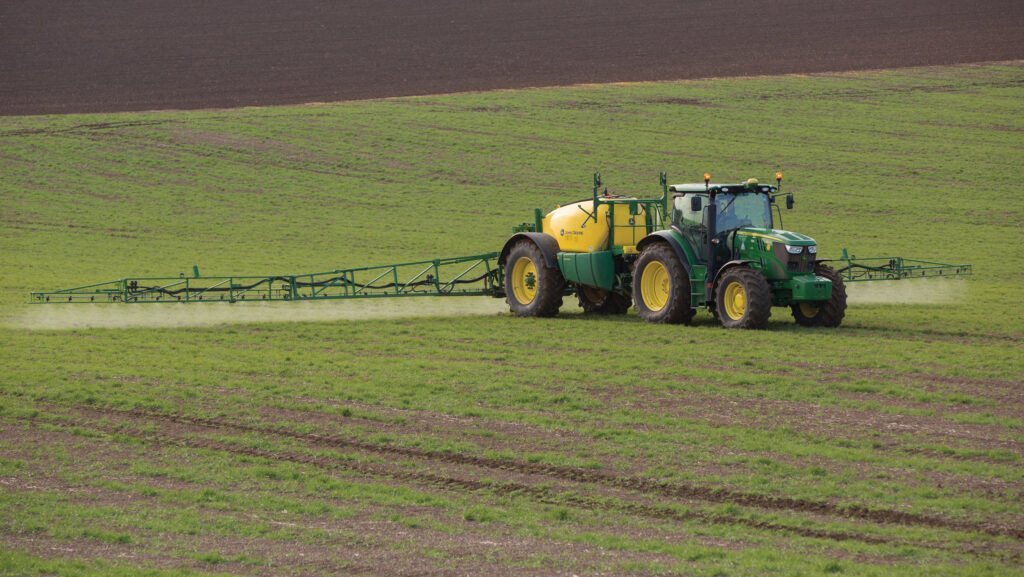Fungicide tips for variable wheat this spring
 © Tim Scrivener
© Tim Scrivener With winter wheat at a wide range of growth stages coming out of winter, extra care will be needed to manage crop development and disease pressure this spring.
Such variability in wheat can prove a challenge for fungicide timings, highlighting the importance of applying treatments according to relevant growth stages, rather than calendar date.
As temperatures and day lengths increase, late-drilled backward crops can develop quickly, which can complicate spray timings, especially if rapid growth results in weaker stems.
See also: How microbial seed dressing helps cut nitrogen fertiliser
Protect photosynthesis
Despite thinner and backward crops, growers are reminded to focus on protecting photosynthetic capacity at T0 and T1 fungicide spray timings.
“Growers are sometimes reluctant to invest in thinner crops, cutting back on early T0 and T1 sprays, only to find they had to chase disease at T2 to get it under control,” says David Howard, head of integrated crop management at agronomy firm Farmacy.
Yellow rust in particular can be pronounced in late-sown or stressed wheats.
“Typically, many wait for growth stage (GS) 30, but crops are sometimes beyond that by the time of application. When catchy weather delays spraying, some may wait until the T1 and perhaps try combining the two.
“Having a gap between T0 and T1 is beneficial, so be flexible with the early timing. If disease is present and you are 2-4 weeks out from T1, it is worth treating, subject to product label restrictions.”
The T0 fungicide may not offer the same yield responses as later treatments, but it sets the foundations for effective disease management, and crucially, helps manage the pressure on subsequent treatments and key yield-building leaves.
Many products can only be used from GS 30, but there are some that can be applied earlier, including biologicals.
Rust focus at T0
Last year saw a particularly early appearance of brown rust, and after a high pressure season, there could be more inoculum this spring, says David.
Although much depends on the impact of winter frosts in reducing inoculum, or at least delaying onset. Equally, milder conditions, like last season, could result in earlier rust pressure.
“Rust management is a numbers game; you must act early to slow it down before inoculum builds. An effective T0 is a ‘no-brainer’ for anyone growing wheat in higher rust-risk areas of eastern counties,” says David.
Essex and Suffolk-based Farmacy agronomist Tom Smith agrees:
“While there has been a bit of septoria bubbling away on older leaves, we’ve not seen much yellow rust in crops so far, but that could change quickly once conditions warm up.”
In most situations, Tom says tebuconazole is his preferred option for controlling yellow rust at T0, in combination with a strobilurin such as azoxystrobin for extra persistence.
“For those looking to boost septoria protection, consider including a multi-site like folpet,” he notes.
Fungicide choice should be based on individual situations. Consider: variety, growth stage, previous cropping, drill date, weather, and what diseases are in the field.
Plant growth regulator benefit
GS30 is also an optimum time to apply a plant growth regulator (PGR), such as trinexapac-ethyl or chlormequat, to manipulate plant growth, says Tom.
“The aim is to control apical dominance and help balance the flow of nutrients and energy across the leaves, stems and developing spikelets, giving the plant the best chance of retaining as many tillers as it can, with strong stems and large ears.”
There is an important distinction between early growth “manipulation” and the use of PGRs at the later GS31/32 or 37/39 timings, where the focus is on growth “regulation” by shortening and strengthening the stem to reduce lodging risks, he notes.
Nutritional boost
Supporting root development of backward crops is an important consideration at T0, and phosphite-based biostimulants have been shown to boost root growth and tiller retention, as well as enhancing PGR effects.
Ideally, they need to be used early, typically at GS30, although there may be some benefit up to GS31.
Trace elements can be a useful addition to support healthy crop growth, particularly where previous soil testing has highlighted deficiencies.
“Many growers might already include magnesium or manganese, but a number of soil tests have come back showing low levels of zinc and boron on several farms, so these may be worth including at T0 and T1 where necessary,” says Tom.

